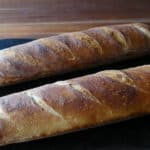
Fresh Homemade French Baguette Recipe
There’s nothing quite like the chewy taste and crusty texture of a freshly baked French baguette. While baguettes may seem intimidating for home bakers, the basic ingredients are simple and with a few tips on technique, you can make perfect, crusty baguettes at home.
Servings 24
Ingredients
- 5 ⅓ cups bread flour 24 ounces (680 grams)
- 2 tablespoon granulated sugar 1 ounce (28.5 grams)
- 2 teaspoon salt .5 ounce (14 grams)
- 2 ¼ teaspoon instant yeast .25 ounce (7 grams)
- 2 cups water 16 ounces (454 grams), lukewarm (about 100°F or 38°C)
Instructions
- Combine bread flour, sugar, salt, and instant yeast in the bowl of a stand mixer. [See note 1]. Add the water and mix, using the dough hook, on the medium-low setting for 5 minutes. Let the dough rest for 10 minutes, and mix again for another 5 minutes.
- Using a dough scraper, transfer the dough to a greased large container. [See note 2]
- Stretch and fold the dough onto itself with wet or oiled hands [See note 3]. Cover with a lid or lightly greased plastic wrap.
- Let the dough rise until almost doubled (about 1 to 2 hours). [See note 4]
- Turn the dough onto a floured surface. Avoid deflating the dough while you handle it. Cut the dough in half using a dough scraper. I like to weigh the portions to make sure they are equal in size.
- Working with one piece at a time, gently pat the dough into a 5×8 in. (13x20 cm.) rectangle, with the long side facing you. Fold the dough letter style: pick up the right side of the dough and fold a third of the way over. Fold the left side of the dough over the first fold, like you would fold a letter.
- Take the edge of the dough furthest away from you (the top edge) and roll the dough towards you, pinching the dough onto itself as you roll, to make it a tight roll. The dough will be a thick log shape. Pinch the seams to seal and create a smooth log.
- Gently shape the log into a baguette shape. My baguette pan is about 16 inches long, so I make the loaves about 13 to 14 in. (33 to 35 cm.) long.
- Carefully transfer the loaves to the baguette pan. Cover the pan loosely with a greased plastic wrap and allow the loaves to rise until they’re about 1 ½ times their original size (about 1 ½ hours) at room temperature.
- Place one rack in the lowest row of the oven and another rack in the middle row. Place an old cake pan in the middle of the lowest rack. Preheat the oven to 500 degrees Fahrenheit (260 degrees Celsius) or as hot as your oven will go. [See note 5]
- Remove the plastic wrap from the loaves 10 minutes before baking. Before putting the baguettes in the oven, use a sharp serrated knife to create ½ inch-deep diagonal cuts across the loaf. Slide the knife at a sideways angle, and not straight down, to create these slits.
- Just before putting the loaves in the oven, spray the loaves with a thin layer of water, or use clean hands to rub some water onto the loaves without deflating them.
- Once the oven is hot, open the door, slide the baguette pan onto the middle rack, and using an oven mitt, pull out the lower rack that has the cake pan. Pour one cup of hot water into the cake pan, slide the rack back in, and close the oven door. Wear long sleeves and use oven mitts to avoid being scalded.
- Lower the oven temperature to 425 degrees Fahrenheit (218 degrees Celsius). Bake the bread for 32 minutes. [See note 6]
- After 12 minutes, rotate the baking pan 180 degrees, and loosely cover the bread with aluminum foil and continue baking.
- Measure the internal temperature of the bread. It’s perfect at 190 degrees Fahrenheit (88 degrees Celsius). Cool the bread completely on a wire rack before slicing.
Video
Notes
- Note 1: Use a kitchen scale to measure ingredients for best results.
- Note 2: I use a plastic bowl with a lid, but you can cover your bowl with greased plastic wrap if you don't have a lid.
- Note 3: To stretch and fold, reach under the front side of the dough, stretch the dough towards you, and fold it back onto the top of the dough. Repeat this from the back and each side. Watch the video in the recipe card for more help.
- Note 4: The time it takes for the dough to rise will depend on the surrounding temperature. You can also let the dough rise slowly in the fridge. If you do this, bring the dough to room temperature before proceeding with the recipe.
- Note 5: In a later step, you will add hot water to the pan to create a steamy environment in the oven. Preheating the oven to a high temperature can take some time, so plan accordingly.
- Note 6: The timings can vary based on how hot your oven runs. Use a digital thermometer to measure the internal temperature of the bread.
- Baking bread requires a few techniques for success. See the blog post for more detailed recipe tips.
Nutrition
Serving: 1serving (1/10 of a loaf) | Calories: 121kcal | Carbohydrates: 24g | Protein: 4g | Cholesterol: 5mg | Sodium: 234mg | Fiber: 1g | Sugar: 1g